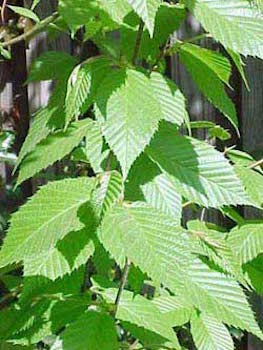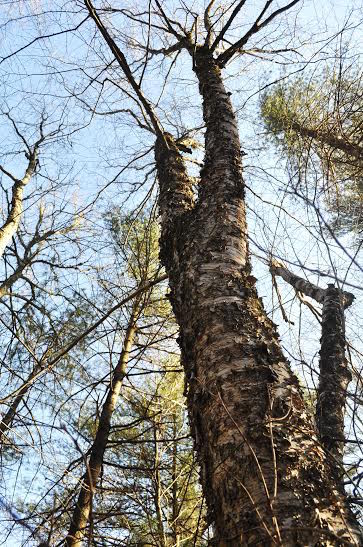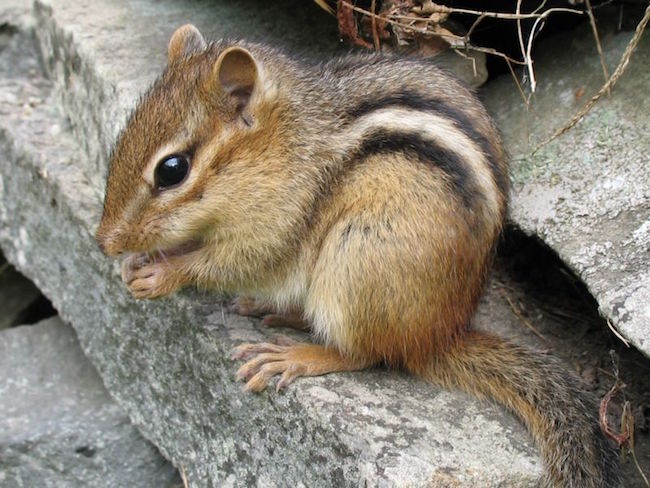Newsletters
May 2016 - Yellow Birch, Eastern Chipmunk
WELCOME TO GREEN FUTURES !
MAY, 2016
“I willingly confess to so great a partiality for trees as tempts me to respect a man in exact proportion to his respect for them.” -James Russell Lowell
“I frequently tramped eight or ten miles through the deepest snow to keep an appointment with a beech-tree, or a yellow birch, or an old acquaintance among the pines.” -Henry David Thoreau
BIORESERVE FLORA OF THE MONTH – Yellow Birch (Betula alleghaniensis)

Photo – U.S. Fish and Wildlife Service
The yellow birch is named for its shaggy bark which is yellowish-bronze to silver-gray with the shaggy pieces curling from the underbark in strips. A curly strip of yellow birch bark can be used as tinder for starting a fire even on a rainy day.

Yellow birch can reach 70 feet in height when growing under ideal conditions. Average height is 30 to 40 feet with a trunk diameter of 2 feet. It grows best on well drained, moist soils along streams, in ravines and on the cool lower slopes of mountain hollows. Yellow birch is often found in small groves mixed in among other species such as maple, beech, hemlock and spruce.
The sap and inner bark, cambium layer, smell of wintergreen and along with the black birch they are tapped to make oil of wintergreen and birch syrup.
Leaves are alternate, simple 3 to 4 inch long ovals, 2 inches high with serrated edges and light green in color.
Birch flowers are catkins. Catkins are slim, cylindrical, drooping cluster of tiny unisexual flowers with inconspicuous petals. Birch catkins are wind pollinated.
After pollination female catkins develop into inch-long cones and mature over the summer releasing numerous tiny winged-seeds (samaras) in the fall.
Yellow birch is native to northeastern North America from Newfoundland south to New England and south down the Appalachian Mountains to northern Georgia and west from Newfoundland, southeastern Manitoba and south to eastern Minnesota, Wisconsin, Illinois, Indiana, Kentucky and Tennessee.
Of all the birch species ...and there are dozens ...the yellow birch is the most valuable having the hardest and finest wood. The wood is of an off-white to light tan color and was very popular in Colonial America and is still valued today for flooring, plywood and cabinetry.
Many forest birds, from chickadees to wild turkeys eat birch seeds as do voles and wood mice. Ruffed grouse feed on the winter buds and catkins. Deer, rabbits and hares browse the leaves and twigs. Beavers eat the bark. A large number of butterfly and moth caterpillars and other insects eat the foliage. Alien gypsy moth caterpillars can completely defoliate and kill yellow birch. A number of fungal diseases also attack yellow birch often stunting the tree's growth or leaving large cankers where the tree has been successful in containing the disease.
In early spring before wildflowers are blooming newly arriving ruby throat hummingbirds will follow yellow belly sapsuckers and other woodpeckers to feed on the sap dripping from recent sapsucker/woodpecker holes.

BIORESERVE FAUNA OF THE MONTH – Eastern Chipmunk (Tamias striatus)

Photo – Gilles Gonthier, CC by 2.0 Wikimedia Commons
To be a true New England stone wall it must have a resident chipmunk. Stone walls and log piles make ideal shelters for these sprightly little members of the squirrel family. Found in suburbia as well as in mature forests chipmunks require nearby cover to escape their many predators.
Eastern chipmunks are a foot long. They have four toes and a thumb on their front feet and five toes on their back feet. They have grayish-brown fur on their back and tail, white underparts, white around their eyes and reddish-brown fur on the rest of their body. On their sides they have a white stripe running from shoulder to rump bordered by a black stripe above and below.
Chipmunks stay close to home rarely venturing out more than an acre or two from their mainburrow. They have an extensive burrow system that leads from their underground nesting area to multiple exits beneath, among or next to logs, rocks and thick brush. Their burrow system has numerous side chambers where food is stored for the winter. The main nesting area is lined with dry leaves and grass.
Male chipmunks are very territorial and a good part of their day is spent in patrolling their property and chasing other males off their acreage. When not protecting their turf from rivals, chipmunks forage about on the forest floor and up in trees searching for seeds, nuts, roots, bulbs, fruits, mushrooms, birds eggs and insects. Chipmunks have internal cheek pouches which they use to carry food back home to store for winter. They also use their cheek pouches to carry nesting material to their den and to remove excavated dirt from their burrow.
By late October chipmunks plug their burrow entrance with dirt and grass and retire to their nesting chamber where they spend the winter mostly sleeping. Not true hibernators they occasionally wake to feed on their stored food supplies.
Chipmunks make a number of different sounds. When disturbed or suspicious of an intruder they make a continuous chirping sound that lasts until the intruder leaves or they determine the intruder is not a threat. Their vocabulary also consists of whistles, grunts and trills.
Chipmunks breed twice a year. First, when they awake in early spring and again in July. Females give birth, usually 3 to 5 young, sometimes as many as 8. Naked at birth, with closed eyes, they grow rapidly. By the end of their first month their eyes open and when three months old they leave their home burrow and head out to find a territory of their own.
All the usual forest carnivores prey on chipmunks. Snakes can follow them right into their burrows and although the chipmunk may escape out a back exit, if there are any unlucky young in the nesting chamber they will be gobbled up by the lucky snake.
In suburban area and in more extensive woodlands that abut residential development the greatest chipmunk predator is usually the domesticated pet cat. Chipmunks are very curious and will often approach a stationary cat to get a better look. When close enough the cat springs and one less chipmunk resides in suburbia. Free ranging house cats can eliminate chipmunks from a wide area.
Eastern chipmunks are found from southern Quebec and Ontario south to eastern Oklahoma, northern Louisiana and western Florida. The are absent from the southern coastal areas peninsula Florida, Georgia and the Carolinas.
ITEMS OF INTEREST – Received from readers
Nontoxic Living. http://www.savvywomensalliance.org/
Fracking. Not good. http://commondreams.org/news/2016/04/15/dems-debate-fossil-fuels-new-report-shows-fracking-worse-thought
Your honey may be contaminated by neonicotinoids. http://news.harvard.edu/gazette/story/2015/07/pesticide-found-in-70-percent-of-massachusetts-honey-samples/
And, neonicotinoids are killing apparently killing our honey bees. http://www.hsph.harvard.edu/news/press-releases/study-strengthens-link-between-neonicotinoids-and-collapse-of-honey-bee-colonies/
From The Alliance for a Healthy Tomorrow on BPA in food cans. http://www.healthytomorrow.org/2016/03/bpa-study.html
Restoring and expanding the range of the common loon. http://downeast.com/maine-loons/
NYT Editorial on Energy Bill. http://www.nytimes.com/2016/04/21/opinion/mixed-signals-on-energy.html?action=click&pgtype=Homepage&clickSource=story-heading&module=opinion-c-col-left-region®ion=opinion-c-col-left-region&WT.nav=opinion-c-col-left-region&_r=0
Business as usual at the dysfunctional Massachusetts Department of Conservation and Recreation.http://www.recorder.com/News/Local/Environmental-group-decries-proposed-state-forest-cutting-plan-1631126
Peabody Coal files Chapter 11. https://www.washingtonpost.com/news/energy-environment/wp/2016/04/13/coal-titan-peabody-energy-files-for-bankruptcy/
“Mr Peabody's Coal Train as hauled it away.” John Prine “Paradise” https://www.youtube.com/watch?v=bDCsc3CU5ww
Opinion piece on local energy.
http://www.southcoasttoday.com/article/20160414/OPINION/160419704
springtime!!!
May and June are two of the best months to be out in our natural environment here in New England. Great weather to take a hike, paddle a kayak/canoe, ride a bike, explore anew nature refuge/sanctuary, go fishing, plant some flowers in a garden, go birding, fly a kite, sniff some wildflowers in the woods …whatever. Click here to see a few springtime offerings.
“The world's favorite season is spring. All things seem possible.”
- Edwin Way Teal
<Back
Social